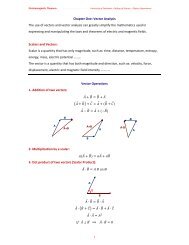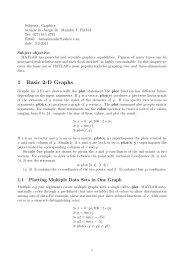An Agent based Image Steganography using Information Theoretic ...
An Agent based Image Steganography using Information Theoretic ...
An Agent based Image Steganography using Information Theoretic ...
Create successful ePaper yourself
Turn your PDF publications into a flip-book with our unique Google optimized e-Paper software.
MASAUM Journal of Computing, Volume 1 Issue 2, September 2009 261<br />
" As <strong>Agent</strong> is a computer system that is situated in<br />
some environment and that is capable of autonomous<br />
action in this environment in order to meet it design<br />
objective".<br />
Let us note that we are talking about (software agent)<br />
whenever or any other researchers in the field say (agent),<br />
we really mean software agent. The typical dictionary<br />
definition of agent, as <strong>An</strong> entity having the authority to act<br />
on behalf of another [14].<br />
Some definitions were tied to specific implementation<br />
technology such as being <strong>based</strong> on theorem proves , or<br />
<strong>using</strong> internal data structure corresponding to the socalled<br />
mentalist concepts , such as beliefs or knowledge ,<br />
goal or desires , intention , and so on.<br />
So a good working definition of agent is that [15]:<br />
"It is a persistent computational entity that can<br />
perceive, reason, Act, and communicate".<br />
A. Software <strong>Agent</strong> Properties<br />
The basic properties of software agent are that they are:<br />
• Autonomous: being autonomous, mean that agents are<br />
independent and make their own decision, this is one<br />
property that distinguish agent from object.<br />
• Situated ness : dose not constrain the notion of an agent<br />
very much since virtually all software can be consider to<br />
be situated in an environment [14].<br />
• Flexibility : can be define to include the following<br />
property :<br />
I. Responsive: Refer to agent ability to perceive its<br />
environment and respond in a timely fashion to change<br />
that occur in it.<br />
II. Pro-active : <strong>Agent</strong> are able to exhibit opportunistic ,<br />
goal –driven behavior , take initiative where appropriate<br />
III. Social: <strong>Agent</strong> should be able to interact, where<br />
appropriate, with other agent or human in order to solve<br />
their own problem and help other with their activities.<br />
B. <strong>Agent</strong> Classification<br />
The various definitions involve a host properties of an<br />
agent. Having settled on a much less restrict definition of<br />
an agent, this property may help us further classify agents<br />
in useful ways.<br />
<strong>Agent</strong> may be usefully classified according to the subset<br />
of these properties that they enjoy. Every agent by our<br />
definition, satisfies the first four property, adding other<br />
property reduce potentially useful classes of agents. For<br />
example: mobile, learning agent. Thus a hierarchical<br />
classification <strong>based</strong> on set inclusion occurs naturally.<br />
There are of course other possible classifying scheme ,<br />
for example , we might classify software agent according<br />
to the tasks they perform. For example, information<br />
gathering agents or email filtering agent , or we might<br />
classify them according to their control architecture. Then<br />
would be fuzzy agent. Also agent could be classified by<br />
the range and sensitivity of their senses , or by the much<br />
internal state they posses [16].<br />
IV. PROPOSED IMAGE STEGANORGRAPHY BASED ON<br />
AGENT<br />
This paper uses two methods of steganorgraphy, the<br />
first one is the discrete cosine transform (DCT)<br />
<strong>Steganography</strong> , and the second one is least significant bit<br />
(LSB) steganorgraphy .<br />
A. The Proposed <strong>Agent</strong> System in steganorgraphy<br />
Our approach make general assumption about agent .<br />
Also in this section we dedicate to present images<br />
database which used by the agents. According to some<br />
features of media (image) the agent will recommend the<br />
user to select the best cover (image) and the suitable<br />
image steganorgraphy methods that are assumed to be<br />
available in this project for the selected secret image .<br />
The Model of proposed steganorgraphy <strong>based</strong> agents<br />
shown in Fig. 2, can be classified as: server agents, which<br />
provides services to other. Since the Client- Server<br />
connection is assumed to be used in this system, the<br />
server (PC ) will provide the client with the STEGO.bmp<br />
file ,which contains the secret image.<br />
The basic role of agents in the system is to select image<br />
from a database of images and make analyses of number<br />
of image features , and according to these features, the<br />
agent will choose the suitable steganography method and<br />
best cover for the specific steganography method, and<br />
give the user a recommendation for selected cover and<br />
selected steganography system .<br />
B. <strong>Agent</strong> system for <strong>Image</strong> feature calculation<br />
In this system, the agent will place at random on<br />
image (the environment). The choice of cover image is<br />
important because it is significantly influences the result<br />
obtained from the proposed system, and it will affect the<br />
resulted security of the whole system.<br />
The calculated image features by agent are:<br />
• Histogram : is a plot of gray level values versus the<br />
number of pixels. The histogram used as probability<br />
distribution of gray level:<br />
P (g) = N ( g)<br />
(3)<br />
M<br />
Where M :is number of pixels in image .<br />
N (g): is number of pixels at gray level g.<br />
• Mean: is the average value, so it tells something<br />
about general brightness of the image.<br />
−<br />
I( r,<br />
c)<br />
(4)<br />
g = ∑∑<br />
r c M<br />
Where I(r,c) is the image pixel value.<br />
• Standard deviation : which is known as square<br />
root of variance. It tells something about contrast ,<br />
and describes and expressed as follows:<br />
L 1 −<br />
=<br />
σ ( g − g ) p(<br />
g)<br />
(5)<br />
g<br />
g∑ −<br />
= 0<br />
261

















